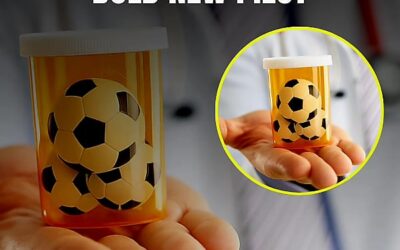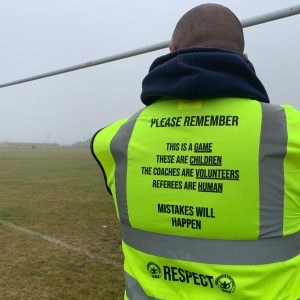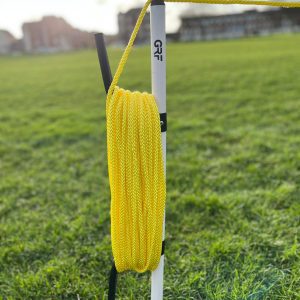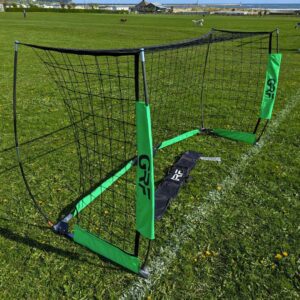AGE GROUP GUIDANCE
Heading should not be introduced in training sessions at this age.
The Foundation Phase DNA aims to provide an enjoyable and memorable experience for young children. Priority at this age is fun engagement and the mastery of both the body and the ball.
In today’s modern game, children will play on smaller pitches, with less players and with the retreat line rule to encourage players to play through the thirds. There is now a greater emphasis at all levels to retain and love the ball and you will see very few headers in the game of Mini Soccer.
Coaches should use the time they have with players to maximise enjoyment and development of other skills, particularly the fundamentals of working with the ball in their hands and feet. Focus should be on learning to master the ball and the body through fun activities.
Heading remains a low priority and our expectation is that heading should not be introduced at this stage.
However, if coaches feel it necessary to introduce the technique of heading, due to the increased heading activity in the game, we strongly advise a maximum of one session per month with light balls, limited repetition of a maximum of five headers, using self-serve or short distances. These limited sessions should introduce the technique of heading and should always be unopposed.
The Youth Development Phase DNA continues to provide an enjoyable and memorable experience for young players. The priority as players get older is still fun, engagement and mastery of both the body and the ball. Players at this age are ready to cope with more decision making, which is reflected in the challenges provided in both training and games. This will still be done within an environment that is both supportive and positive. While there may be a small increase in the number of headers seen in the game at this age group, it will remain a low priority when compared to other technical aspects of the game.
Coaches should continue to use the time they have with players to maximise the development of other key skills seen more regularly in the game at this age.
Heading remains a low priority and our expectation is that heading should not be introduced at this stage.
However, if coaches feel it necessary to introduce the technique of heading, due to the increased heading activity in the game, we strongly advise a maximum of one session per month with light balls, limited repetition of a maximum of five headers, using self-serve or short distances. These limited sessions should introduce the technique of heading and should always be unopposed.
The Youth Development Phase DNA continues to provide an enjoyable and memorable experience for young players. The priority as players get older is still fun, engagement and mastery of both the body and the ball. Players at this age are ready to cope with more decision making, which is reflected in the challenges provided in both training and games. This will still be done within an environment that is both supportive and positive. While there may be a small increase in the number of headers seen in the game at this age group, it will remain a low priority when compared to other technical aspects of the game.
Coaches should continue to use the time they have with players to maximise the development of other key skills seen more regularly in the game at this age.
Heading remains a low priority.
Players can be introduced to the basic concepts in training with limited repetition. Coaches should not focus on heading practice more than one session per week and limit the number of headers per player to 10 per session. Coaches should use a variety of distances relative to the game at this age.
The Youth Development Phase DNA continues to provide an enjoyable and memorable experience for young players.
Priority is still fun, engagement and the mastery of both the body and the ball. Players at this age are ready to cope with more decision making, which is reflected in the challenges provided in both training and games. This will still be done within an environment that is both supportive and positive.
As players’ knowledge of the game and physical strength develops, there will be more visible tactical use of restarts, resulting in an increased number of headers.
There are key factors to consider when introducing the technique of heading as part of a balanced programme, which include:
• Judge and adjust to the flight of the ball
• Attack the ball at optimum point
• Head contact and ball contact to control direction and distance of the ball
Different types of headers will start to be used, so coaches can introduce position-specific movement patterns.
RECOMMENDATION: LIMITING HEADING IN TRAINING
These recommendations have been developed to protect players welfare. As further research is undertaken this guidance will be reviewed and updated to reflect increased understanding.
It is recommended that heading practice is limited to 10 headers per session and only one session a week where heading practice is included. Players should be responsible for monitoring their own heading activity.
Heading remains a low priority.
As the game begins to replicate the adult game coaches should use a variety of heading situations players will experience during a game. This includes the introduction of contested headers. While you may now use match balls in the session light balls can still be used in training when practising the technique of heading.
The Youth Development Phase DNA continues to provide an enjoyable and memorable experience for young players.
Priority is still fun, engagement and the mastery of both the body and the ball. Players at this age are ready to cope with more decision making, which is reflected in the challenges provided in both training and games. This will still be done within an environment that is both supportive and positive.
As players’ knowledge of the game and physical strength develops, there will be more visible tactical use of restarts, resulting in an increased number of headers.
There are key factors to consider when introducing the technique of heading as part of a balanced programme, which include:
• Judge and adjust to the flight of the ball
• Attack the ball at optimum point
• Head contact and ball contact to control direction and distance of the ball
Different types of headers will start to be used, so coaches can introduce position-specific movement patterns.
RECOMMENDATION: LIMITING HEADING IN TRAINING
These recommendations have been developed to protect players welfare. As further research is undertaken this guidance will be reviewed and updated to reflect increased understanding.
It is recommended that heading practice is limited to 10 headers per session and only one session a week where heading practice is included. Players should be responsible for monitoring their own heading activity.
LIMITING HEADING IN TRAINING
These recommendations have been developed to protect players welfare. As further research is undertaken this guidance will be reviewed and updated to reflect increased understanding.
It is recommended that heading practice is limited to 10 headers per session and only one session a week where heading practice is included. Players should be responsible for monitoring their own heading activity.
GUIDANCE FOR COACHES
It is acknowledged there is a significant amount of further research required which will inform further iterations of this guidance. The aim of this guidance is to reduce overall exposure to heading without compromising development of technique and the role heading plays in the (English) game. The role of the coach in supporting players’ skill development for heading is to ensure a safe and controlled technique. It is recommended when designing heading related activities these points are considered:
• What is it that occurs in the game that you are preparing the players to do? What is the best way to prepare the players to do this?
• How often do the various types of heading occur in the context that your players play?
• Quality v Quantity – Ensure you focus is on the technique of heading, rather than the volume of headers.
• Different types of headers results in different impacts on the head. The focus for the coach is to support their players in developing safe and controlled technique for both attacking and defensive headers, including contested and uncontested headers.
• A recent study in the professional game observed that headers completed following a longball and cross (over 35- 45m distance) were likely to result in the highest loads on a player’s head. Therefore, coaches should consider this when practicing set plays such as corners and final 3rd free-kicks and attacking play.
• Wherever possible limit the number of headers carried out when a player takes more than three steps and runs onto a ball or dives for a ball.
• Practice technique using thrown passes to reduce the potential load on the head.
• It is important to ensure that the balls used are appropriate in terms of “wear and tear”, ensuring the surfaces are smooth and no water is being held, which would make the ball heavier.
It is recognised that in Adult football there will be a more visible tactical use of restarts, resulting in potentially an increased number of headers. Please consider how you plan these activities limiting the opportunity for repetitive heading of certain players.
There are key factors to consider when introducing the technique of heading as part of a balanced programme, which include:
• Judge and adjust to the flight of the ball
• Attack the ball at optimum point
• Head contact and ball contact to control direction and distance of the ball
Different types of headers will be more prevalent in certain positions, so coaches should introduce position specific training and support. Players playing in certain positions will head the ball more often, coaches should be aware of this and therefore plan accordingly to ensure players aren’t exposed to long periods of repetitive heading.








0 Comments